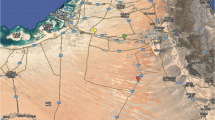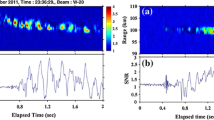Abstract
The ionization heights of meteor trails are strongly dependent on local atmospheric conditions in the mesosphere and lower thermosphere (MLT)-region. We present here latitudinal difference in ionization heights of meteor trails at two distinct latitudes, Thumba (8.5∘N, 77∘E), India and Eureka (80∘N, 85.8∘W), Canada. There is a large seasonal variation in meteor count at high latitude as compared to low latitude. Similarly, there is a large variation in meteor trail ionization heights at high latitudes, but not at low latitudes. However, it noticed that the trail ionisation heights at low latitude are found to be about 2 km higher. The latitudinal differences are probably related to changes in electron line densities at local MLT-regions. The identification of meteoroid streams in the sporadic background is still a noteworthy problem to pursue. By considering ionisation heights of meteor trails as a simple but robust metric, we identified shower meteors from the background sporadic activity, as the ionization heights of shower meteors are different from the sporadic meteors. We apply this shower detection technique on long-term data set at two different latitudes and compared with existing shower calendars. By using the median height of meteor trails and their corresponding upper and lower quartiles (Uq and Lq) as a metric, we unambiguously identified all northern hemisphere showers with a zenithal hourly rate larger than 20, which are in good agreement with the known showers.







Similar content being viewed by others
References
Bronshten, V.A.: Physics of Meteor Flight in the Atmosphere. Reidel, Dordrecht (1983)
Brown, P., Weryk, R., Wong, D., Jones, J.: A meteoroid stream survey using the Canadian Meteor Orbit Radar: I. Methodology and radiant catalogue. Icarus 195(1), 317–339 (2008)
Ceplecha, Z., Borovicka, J., Elford, W.G., Revelle, D.O., Hawkes, R.L., Porubcan, V., Simek, M.: Meteor phenomena and bodies. Space Sci. Rev. 84, 327–471 (1998)
Cziczo, D.J., Thomson, D.S., Murphy, D.M.: Ablation, flux, and atmospheric implications of meteors inferred from stratospheric aerosol. Science 291, 1772–1775 (2001)
Dyrud, D., Oppenheim, L.M., Vom Endt, A.: The anomalous diffusion of meteor trails. Geophys. Res. Lett. 28(14), 2775–2778 (2001)
Hall, C.M., Dyrland, M.E., Tsutsumi, M., Mulligan, F.J.: Temperature trends at 90 km over Svalbard, Norway (78∘N l6∘E), seen in one decade of meteor radar observations. J. Geophys. Res. 117, D08104 (2012)
Herlofson, N.: The theory of meteor ionization. Rep. Prog. Phys. 11, 444–454 (1947)
Hocking, W.K.: Radar meteor decay rate variability and atmospheric consequences. Ann. Geophys. 22, 3805–3814 (2004)
Hocking, W.K., Fuller, B., Vandepeer, B.: Real-time determination of meteor-related parameters utilizing modern digital technology. J. Atmos. Sol.-Terr. Phys. 63, 155–169 (2001)
Jacchia, L.G., Kopal, Z., Millman, P.M.: A photographic study of the Draconid meteor shower of 1946. Astron. Phys. J. 111, 104–133 (1950)
Jenniskens, P.: Meteor Showers and Parent Comets. Cambridge University Press, Cambridge (2006)
Jenniskens, P.: Meteor showers in review. Planet. Space Sci. 143, 116–124 (2017)
Jones, J., Webster, A.R., Hocking, W.K.: An improved interferometer design for use with meteor radars. Radio Sci. 33(1), 55–66 (1998)
Jopek, T.J., Kanuchova, Z.: Current status of the IAU MDC Meteor Showers Database. In: Jopek, T.J., Rietmeijer, F.J.M., Watanabe, J., Williams, I.P. (eds.) Meteoroids 2013. Proceedings of the Astronomical Conference Held at A.M. University, Poznan, Poland, Aug. 26–30, 2013 pp. 353–364. A.M. University, Poznan (2014)
Kelley, M.C.: The Earth’s Ionosphere: Plasma Physics and Electrodynamics. Elsevier, New York (2009)
Kim, J.H., Kim, Y.H., Lee, C.S., Jee, G.: Seasonal variation of meteor decay times observed at King Sejong station (62.22∘S, 58.78∘W). Antarctica. J. Atmos. Sol.-Terr. Phys. 72, 883–889 (2010)
Kim, J.H., Kim, Y.H., Jee, G., Lee, C.S.: Mesospheric temperature estimation from meteor decay times of weak and strong meteor trails. J. Atmos. Sol.-Terr. Phys. 89, 18–26 (2012)
Koten, P., Spurn, P., Borovika, J., Stork, R.: Extreme beginning heights for non-Leonid meteors. In: Proceedings, Meteoroids 2001 Conference, pp. 119–122 (2001)
Koten, P., Spurn, P., Borovicka, J., Evans, S., Elliott, A., Betlem, H., Stork, R., Jobse, K.: The beginning heights and light curves of high-altitude meteors. Meteorit. Planet. Sci. 41(9), 1305–1320 (2006)
Kozlovsky, A., Lester, M.: On the VHF radar echoes in the region of midnight aurora: signs of ground echoes modulated by the ionosphere. J. Geophys. Res. Space Phys. 120, 2099–2109 (2015)
Kumar, K.K., Ramkumar, G., Shelbi, S.T.: Initial results from SKiYMET meteor radar at Thumba (8.5∘N, 77∘E): 1. Comparison of wind measurements with MF spaced antenna radar system. Radio Sci. 42, RS6008 (2007)
Love, S.G., Brownlee, D.E.: Heating and thermal transformation of micromete- oroids entering the Earth’s atmosphere. Icarus 89, 26–43 (1991)
Lovell, A.C.B.: Meteor Astronomy, pp. 21–30. University Press, Oxford (1954)
Lukianova, R., Kozlovsky, A., Lester, M.: Recognition of meteor showers from the heights of ionization trails. J. Geophys. Res. Space Phys. 123, 7067–7076 (2018)
Manning, L.A., Villard, O.G. Jr., Peterson, A.M.: The length of ionized meteor trails. Am. Geophys. Union 34(1), 16–21 (1953)
Murray, I.S., Hawkes, R.L., Jenniskens, P.: Airborne intensified charge-couple device observations of the 1998 Leonid shower. Meteorit. Planet. Sci. 34, 949–958 (1999)
Oppenheim, M.M., Dimant, Y.S.: First 3-D simulations of meteor plasma dynamics and turbulence. Geophys. Res. Lett. 42, 681–687 (2015)
Picone, J., Hedin, A., Drob, D., Aikin, A.: NRLMSISE-00 empirical model of the atmosphere: statistical comparisons and scientific issues. J. Geophys. Res. 107(A12), 1468 (2002)
Plane, J.M.: Atmospheric chemistry of meteoric metals. Chem. Rev. 103, 4963–4984 (2003)
Plane, J.M.: Cosmic dust in the Earth’s atmosphere. Chem. Soc. Rev. 41, 6507–6518 (2012)
Plane, J.M., Feng, W., Dawkins, E.C.: The mesosphere and metals: chemistry and changes. Chem. Rev. 115, 4497–4541 (2015)
Premkumar, B., Chenna Reddy, K., Yellaiah, G., Kishore Kumar, K.: Seasonal variations in vertical distribution of meteor decay time as observed from meteor radars at 8.5∘N and 80∘N. Adv. Space Res. 63, 1661–1669 (2019)
Rudawska, R., Matlovic, P., Toth, J., Kornos, L.: Independent identification of meteor showers in EDMOND database. Planet. Space Sci. 118, 38 (2015)
Sekhar, A., Asher, D.J.: Meteor showers on Earth from sungrazing comets. Mon. Not. R. Astron. Soc. 433, L84 (2013)
Singer, W., von Zahn, U., Weis, J.: Diurnal and annual variations of meteor rates at the arctic circle. Atmos. Chem. Phys. 4, 1355–1363 (2004)
Stober, G., Matthias, V., Brown, P., Chau, J.L.: Neutral density variation from specular meteor echo observations spanning one solar cycle. Geophys. Res. Lett. 41, 6919–6925 (2014)
Szasz, C., Kero, J., Pellinen-Wannberg, A., Mathews, J.D., Mitchell, N.J., Singer, W.: Latitudinal variations of diurnal meteor rates. Earth Moon Planets 95, 101–107 (2005)
Vinkovic, D.: Thermalization of sputtered particles as the source of diffuse radiation from high altitude meteors. Adv. Space Res. 39, 574–582 (2007)
Ye, Q., Brown, P.G., Campbell-Brown, M.D., Weryk, R.J.: Radar observations of the 2011 October Draconid outburst. Mon. Not. R. Astron. Soc. 436(1), 675–689 (2013)
Yi, W., Reid, I.M., Xue, X., Murphy, D.J., Hall, C.M., Tsutsumi, M.: High- and middle-latitude neutral mesospheric density response to geomagnetic storms. Geophys. Res. Lett. 45, 436–444 (2018)
Younger, P., Astin, I., Sandford, D., Mitchell, N.: The sporadic radiant and distribution of meteors in the atmosphere as observed by VHF radar at Arctic, Antarctic and equatorial latitudes. Ann. Geophys. 27, 2831–2841 (2009)
Younger, J.P., Reid, I.M., Vincent, R.A., Murphy, D.J.: A method for estimating the height of a mesospheric density level using meteor radar. Geophys. Res. Lett. 42, 6106–6111 (2015)
Acknowledgements
The authors thankful to Dr. Geetha Ramkumar, SPL, VSSC, India and CANDAC team, Canada for data support. The Eureka meteor radar is part of the Canadian Network of the Detection of Atmospheric Change (CANDAC) project.
Author information
Authors and Affiliations
Additional information
Publisher’s Note
Springer Nature remains neutral with regard to jurisdictional claims in published maps and institutional affiliations.
Rights and permissions
About this article
Cite this article
Chenna Reddy, K., Premkumar, B. & Yellaiah, G. Latitudinal difference in meteor trail ionization heights and identification of meteor showers. Astrophys Space Sci 364, 203 (2019). https://doi.org/10.1007/s10509-019-3687-9
Received:
Accepted:
Published:
DOI: https://doi.org/10.1007/s10509-019-3687-9




